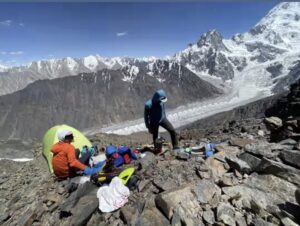Nirmal Purja, or Nims for short, needs little introduction these days. Over the past few months, he’s summited 11 of the 8000’ers in a mere 94 days. He has also helped in four rescues during this time, including the extraction of Wui Kin Chin from high on Annapurna. The former special forces soldier has just three peaks left on his lofty tick list: Manaslu, Cho Oyu and Shishapangma. ExWeb caught up with Purja during his brief downtime before he tackles the remainder of his Project Possible.
If you succeed, can you pinpoint what factors have allowed you to do this so quickly?
When I finish the challenge! You cannot have any doubt in your mind. Yes, I will always treat every mountain with respect, but I also know that I will finish this.
It has been a combination of mindset, training and my own physiology. I don’t know the science bit but I do know what my body can do and I listen to it. But I can’t listen to it when I am coming down off a summit and I have used every ounce of energy. That is when I focus my mind and I say to myself, “How can I tell my story if I don’t get back?”

Looking over to K2 and Broad Peak from the summit of Gasherbrum II. Photo: Nirmal Purja
Who is the strongest climber you have climbed with this year, and why?
Probably Mingma David Sherpa. He is someone who respects the mountains, has a positive mindset and holds his own records for climbing. He’s a great friend, and we both know that we have each other’s backs, which is very important in the mountains.
Some climbers see your challenge as a test more of physical performance rather than mountaineering skills. How do you respond?
To climb the world’s 14 highest mountains in seven months, you have to have both physical strength and skill; you can’t separate the two. How can I lead climbers up K2 without technical skill? How can I rescue people without physical performance?
If you have mountaineering skills but no stamina, then you can’t expect to reach the summit. If you blindly go up a mountain at speed, then you don’t respect it, and you will waste energy using the wrong bits of equipment or taking the wrong route.

The now-infamous photo Purja took of the queues on Everest this season. Photo: Nirmal Purja
How would you answer those who say that your methods during this project are against the spirit of mountaineering?
Who decides what “the spirit of mountaineering” is? Everyone has his or her own reason for climbing a mountain. Look at it this way: I have seen people climbing Mount Everest who have spent all their savings. They say they would prefer to die on the mountain because they have spent all their money. Is that in the spirit of mountaineering?
One of the Alpine Club’s websites defines the spirit of mountaineering as unselfishly giving exceptional assistance to those in need of help in the mountains. I have completed four rescues during my challenge. Does that not fit in with the Alpine Club’s Spirit of Mountaineering?
What routes will you choose for your three remaining 8,000’ers, and who will you climb with?
On any of the previous phases, I haven’t told anyone in advance which route I will take. I’ll determine my route once I am there. I rotate the teams, so once I am back in Nepal, I will decide on the personnel based on their fitness and availability.

Reinhold Messner and Purja at Nanga Parbat Base Camp. Photo: Nirmal Purja
You hinted at climbing K2 in winter. All previous attempts have been made without supplementary oxygen. If you go for it, would you do the same?
I will climb K2 in winter. It is the one giant challenge left. There is a team planning to try this year, so I will wait and see how they do.
I will do it without supplementary oxygen. The only reason that I have used oxygen on this current challenge is because of its scale. You cannot plan a single mountain in isolation. I have to consider the whole phase: the weather, the features of the mountain and the conditions. I have to get back down, so that I can reach the next mountain. I listen to my body. You must have humility so that you can get home. You can always go again without oxygen if that is what is so important, but you can’t if you’re dead.
What are your mountaineering goals after the 8,000’ers?
K2 in winter is high on my list. I also want to focus on my company, Elite Himalayan Adventures, so I can share my skills with anyone who wants to climb. We will have to wait and see. I want to enjoy the last three mountains but first I need to raise the funds to complete it.





